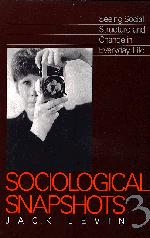

![]()
![]()

During the introductory chapter, Levin advances a specific rationale for the organisation, character and content of the book that relates to this initial concern. The central concept here is described as the 'sociological eye'. This notion is seen to be analogous with the practice and theory of photography. In particular, the documentary power of the 'snapshot' in photography in identifying particular everyday practices and relating them to forms of behaviour and issues is viewed as a suitable conceptual apparatus for a book introducing students to sociology. Sociological snapshots, in the form of a collection of topical (sociologically informed) essays are advanced as mechanisms for achieving a similar aim within the realm of the sociological imagination.
Levin notes that whilst sociology should aim to be value free much sociological work is informed through subjective criteria. We are then warned that whilst the various essays may be written in an informal tone and do not present direct evidence in the form of research data they are all based on 'sociological thinking, sociological data, or both' (p.4). This, it seems, is an article of faith presented at the outset of the book. One may therefore speculate that the logic behind this book assumes that the presentation of data and overt sociological thinking lend themselves to modes of discourse that do not fit into the pedagogical framework favoured for teaching introductory sociology and the concern for generating enthusiasm amongst students taking sociological courses. This is certainly a debatable, if speculative, point.
The main content of the book is broken down into seven units within which a number of sociological snapshots that are thematically related are located. The thematic units include 'culture', 'socialisation', 'the group experience', 'institutions', 'deviance', 'social inequality' and 'social change'. Each snapshot within each of the different units includes a general commentary that provides a contemporary angle on each theme utilising examples from everyday life. This is followed by a 'focus section' within which further reading is identified and summarised and a 'developing ideas section' within which questions, activities and tasks associated with the reading are presented. In many of the examples these sections include relevant reading, accessible summaries and interesting and considered questions and activities for students.
The essays within each section cover a broad range of issues from the powerful effects of social role to the unintended effects of certain forms of planning and policy implementation. One of the more interesting sections discusses the racial divide in the United States (Another Crisis in Black and White? The Coming Race War in America p.161) which provides a number of interesting references, if rather foreboding and pessimistic assessments, of the current state of race relations in that particular country. Indeed, one of the shortcomings of this book is that it is directed mainly at a North American audience. Consequently, much of the examples and anecdotes used are North American as is the origin of the recommended reading. This is not a bad thing in itself but it does detract from more global sociological issues and processes.
[6.] In many respects the organisation of the book provides a coherent and structured resource for teachers and students following an introductory course in sociology. In my view this makes the book particularly useful for seminar work. With more changes looming on the horizon in the Higher Education sector (e.g. the possible introduction of two year associate degrees, the take up of sociological options by students following different major schemes of study and the emergence of a mass education system) this book makes interesting reading. It can be understood as a response to the various challenges that parts of the Higher Education system in the U.S.A. has experienced in recent years. Whilst contemporary developments in Britain may not be exactly the same there are some increasingly clear similarities. Having said that, whilst Sociological Snapshots does provide interesting teaching material and commentary through the use of everyday examples it represents only one response to changes in teaching and learning within sociology. In some cases there is doubt about the level and pitch of the material and it sometimes reads in a very simplistic manner that does not always do justice to the intellectual curiosity of students. On the other hand, it is clearly a considered response to the changing profile of sociology students and the changing character of teaching and learning in Higher Education.
William Housley
Cardiff School of Social Sciences